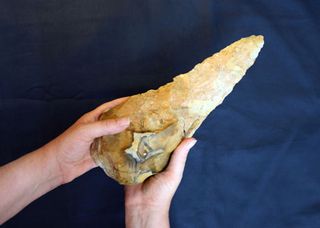'Giant' 300,000-year-old hand ax found in England may have been used for prehistoric butchery
Archaeologists unearthed a collection of hand axes that are the largest and oldest known stone tools found in Britain.

Archaeologists in Kent, England have unearthed a collection of prehistoric hand axes that are among the largest and oldest known stone tools found in Britain.
The ancient artifacts, two of which researchers classified as "giant handaxes," are so enormous that they would've been unwieldy to handle and likely required two hands to operate. The longest in the group measured almost a foot (29.6 centimeters) long, according to a statement.
"These handaxes are so big it's difficult to imagine how they could have been easily held and used," Letty Ingrey, an archaeologist at the University College London Institute of Archaeology, said in the statement. "Perhaps they fulfilled a less practical or more symbolic function than other tools, a clear demonstration of strength and skill."
Based on an analysis of the sediments the artifacts were buried in, the sharp-tipped tools date to an ice age that occurred between 300,000 and 333,000 years ago, according to a study published July 6 in the journal Internet Archaeology.
Related: 54,000-year-old stone points are oldest evidence of bows and arrows in Europe
While the axes' exact purpose is unknown, it's likely that they "would have been used as cutting tools for activities such as butchering animals or cutting meat," Ingrey told Newsweek. "During this period people may have been hunting animals like horse[s], red deer and even straight-tusked elephants."
She added, "At this time, we had early Neanderthal people inhabiting Britain, but there might have been other archaic human species around also."
Sign up for the Live Science daily newsletter now
Get the world’s most fascinating discoveries delivered straight to your inbox.
In addition to the two large axes, researchers discovered a Roman cemetery dating to "at least a quarter of a million years later than the ice age activity." It contains the remains of at least 25 people, including 13 who were cremated in the area. The archaeologists are currently conducting additional research on the cemetery and other artifacts found at the site, which they initially discovered in 2021 during the construction of a new academy, according to the statement.
"We have over 800 artifacts from this site," Ingrey told Newsweek. "However, analysis of the collection and the site is still ongoing, so we'll be sharing information on the rest of the collection in the future."

Jennifer Nalewicki is a Salt Lake City-based journalist whose work has been featured in The New York Times, Smithsonian Magazine, Scientific American, Popular Mechanics and more. She covers several science topics from planet Earth to paleontology and archaeology to health and culture. Prior to freelancing, Jennifer held an Editor role at Time Inc. Jennifer has a bachelor's degree in Journalism from The University of Texas at Austin.
